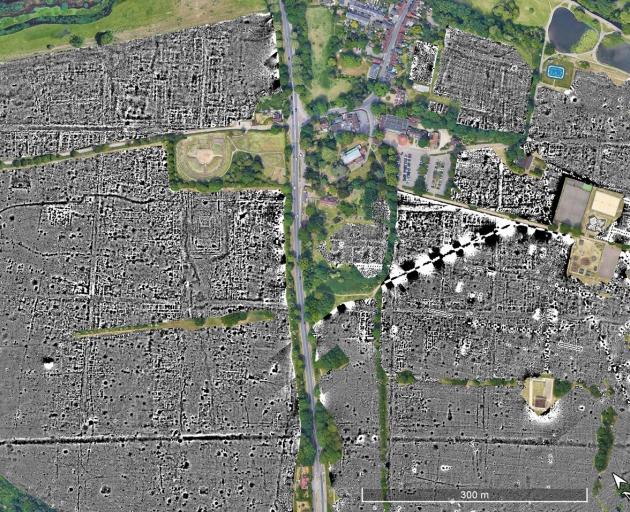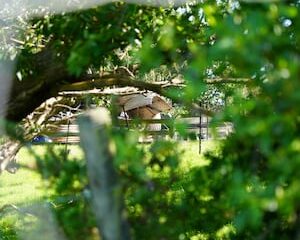Science
New Discoveries Illuminate Ancient Verulamium’s Hidden History

Recent advancements in archaeological methods have unveiled significant discoveries in Verulamium, an ancient Roman city located in present-day St Albans, England. A new geophysical survey technique, expanding rapidly over the site, has provided researchers with a detailed view of the city’s layout, revealing structures and features hidden beneath the surface.
Uncovering the Past with Innovative Technology
This renewed interest in Verulamium dates back to a project involving Martin Aitken, a scientist from Oxford University, who introduced a proton magnetometer to the archaeological team. This device, which includes a bottle, various wires, and a display for electronic signals, was employed to detect underground disturbances. The initial research led to the mapping of an early Roman defensive ditch, likely hastily constructed in anticipation of an attack by Queen Boudicca’s formidable forces.
Recently, an unexpected photograph of the author holding the proton magnetometer prompted a deeper investigation into ongoing developments at the site. The results from the latest geophysical surveys have been astonishing, revealing a comprehensive view of the city that once thrived behind a circuit of stone walls. This method has allowed archaeologists to visualize the layout of streets, houses, kilns, and other critical structures.
Mapping the Ancient City’s Layout
Among the notable features captured in the survey are the forum, a theatre, and a large temple, which were central to the city’s social and cultural life. The grid pattern of streets illustrates how the city was divided into sections, each characterized by fine houses equipped with hypocausts and intricate mosaic floors. Notably, the early defensive ditch is clearly delineated in the latest plans, appearing as a dark line that angles sharply on its western edge.
Interestingly, the team refrained from taking readings where the ditch extends beneath the St Albans first XI cricket pitch, mindful of the groundsman’s potential displeasure. The survey also identified a sinuous dark line representing an aqueduct that once supplied water to the theatre, a critical component of Roman urban infrastructure.
During earlier excavations at Verulamium, the archaeological team discovered a stunning mosaic floor featuring a lion at its center. Such findings suggest that many more treasures remain buried deep underground, waiting to be uncovered as the geophysical survey continues to progress.
As research at Verulamium advances, the collaboration between technology and archaeology promises to shed further light on this fascinating chapter of Roman history. The combination of innovative surveying techniques and historical inquiry ensures that the secrets of Verulamium will continue to be revealed, enriching our understanding of ancient urban life.
-

 World2 weeks ago
World2 weeks agoPrivate Funeral Held for Dean Field and His Three Children
-

 Top Stories2 weeks ago
Top Stories2 weeks agoFuneral Planned for Field Siblings After Tragic House Fire
-

 Sports3 months ago
Sports3 months agoNetball New Zealand Stands Down Dame Noeline Taurua for Series
-

 Entertainment3 months ago
Entertainment3 months agoTributes Pour In for Lachlan Rofe, Reality Star, Dead at 47
-

 Entertainment2 months ago
Entertainment2 months agoNew ‘Maverick’ Chaser Joins Beat the Chasers Season Finale
-

 Sports3 months ago
Sports3 months agoSilver Ferns Legend Laura Langman Criticizes Team’s Attitude
-

 Sports1 month ago
Sports1 month agoEli Katoa Rushed to Hospital After Sideline Incident During Match
-

 World3 weeks ago
World3 weeks agoInvestigation Underway in Tragic Sanson House Fire Involving Family
-

 Politics2 months ago
Politics2 months agoNetball NZ Calls for Respect Amid Dame Taurua’s Standoff
-

 Top Stories2 weeks ago
Top Stories2 weeks agoShock and Grief Follow Tragic Family Deaths in New Zealand
-

 Entertainment3 months ago
Entertainment3 months agoKhloe Kardashian Embraces Innovative Stem Cell Therapy in Mexico
-

 World4 months ago
World4 months agoPolice Arrest Multiple Individuals During Funeral for Zain Taikato-Fox





















